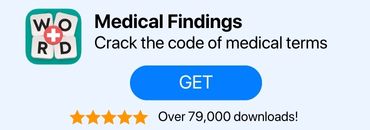This quiz teaches you the common word roots and combining forms that relate to digestive systems.
Quick Review for the Quiz
Check out the flashcard version for a more detailed review.
| Word Root | Combining Form | Body Part or Condition |
|---|---|---|
| abdomin , celi, lapar | abdomin/o , celi/o, lapar/o |
abdomen or abdominal
|
| an | an/o | anus |
| antr | antr/o | antrum |
| append, appendic | append/o, appendic/o | appendix |
| bil, chol | bil/i, chol/e, chol/o | bile, gall |
| bucc | bucc/o | cheek |
| cec | cec/o | cecum |
| cholangi/o | cholangi/o | bile duct |
| cholecyst | cholecyst/o | gallbladder |
| choledoch | choledoch/o |
common bile duct
|
-
Question of
Find the combining form.

-
celi/o or lapar/o
-
pylor/o
-
bucc/o
-
antr/o
Correct Wrong
abdomin/o , celi/o or lapar/o is the combining form that refers to "abdomen" or "abdominal". In the body, the abdomen (also known as the belly) is the space between the thorax (chest) and pelvis. A wide variety of organs are found in the abdomen, including the stomach, the small intestine (jejunum and ileum), the large intestine (colon), the liver, the spleen, the gallbladder, the pancreas, the uterus, the fallopian tubes, the ovaries, the kidneys, the ureters, and the bladder.
-
-
Question of
Find the combining form of the image pointed to.

-
an/o
-
pancreat/o
-
labi/o or cheil/o
-
diverticul/o
Correct Wrong
an/o is the combining form that refers to "anus". Located at the end of the gastrointestinal tract, the anus is the opening through which it exits. Stool is expelled from the body through this area.
-
-
Question of
Find the combining form of the image pointed to.

-
antr/o
-
cec/o
-
steat/o
-
pylor/o
Correct Wrong
antr/o is the combining form that refers to "antrum". The antrum is the lower portion of the stomach that stores the broken-down food until it is ready to be absorbed by the small intestine.
-
-
Question of
Find the combining form of the image pointed to.

-
append/o or appendic/o
-
jejun/o
-
steat/o
-
antr/o
Correct Wrong
append/o or appendic/o is the combining form that refers to "appendix". In the human body, the appendix is a tube-like structure attached to the large intestine, whose function is unknown.
-
-
Question of
Find the combining form of the image pointed to.

-
bil/i or chol/e
-
cholangi/o
-
cholecyst/o
-
pylor/o
Correct Wrong
bil/i or chol/e is the combining form that refers to "bile (gall)". Bile is a fluid produced and released by the liver that is stored in the gallbladder. In the digestive tract, bile breaks down fats into fatty acids that can be absorbed into the body.
-
-
Question of
Find the combining form of the image pointed to.

-
bucc/o
-
labi/o or cheil/o
-
cholangi/o
-
sigmoid/o
Correct Wrong
bucc/o is the combining form that refers to "cheek". The cheeks form the mouth's side wall.
-
-
Question of
Find the combining form of the image pointed to.

-
cec/o
-
sial/o
-
ile/o
-
bucc/o
Correct Wrong
cec/o is the combining form that refers to "cecum". The cecum forms the first portion of the large intestine that connects the small intestine with the colon. Salts and electrolytes are absorbed in the cecum, while solid wastes are lubricated as they pass into the large intestine.
-
-
Question of
Find the combining form of the image pointed to.

-
cholangi/o
-
cholecyst/o
-
choledoch/o
-
esophag/o
Correct Wrong
cholangi/o is the combining form that refers to "bile duct". A series of thin tubes connects the liver to the small intestine called the bile ducts. By allowing bile to flow from the liver and gallbladder into the small intestine, they help digest fats.
-
-
Question of
Find the combining form of the image pointed to.

-
cholecyst/o
-
choledoch/o
-
peritone/o
-
jejun/o
Correct Wrong
cholecyst/o is the combining form that refers to "gallbladder". The gallbladder is an organ that stores and releases bile produced by the liver. It is shaped like a pear and is located under the liver.
-
-
Question of
Find the combining form of the image pointed to.

-
choledoch/o
-
cholecyst/o
-
cec/o
-
enter/o
Correct Wrong
choledoch/o is the combining form that refers to "common bile duct". The common bile duct distributes bile from the liver and gallbladder to the pancreas, and then to the small intestine. In the small intestine, the common bile duct joins the ducts from the liver and gallbladder.
-




